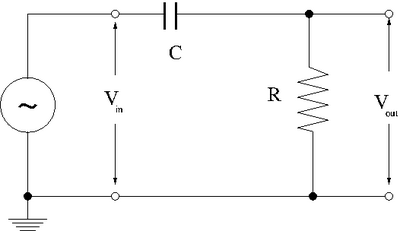Difference between revisions of "Lab 4 RS"
Jump to navigation
Jump to search
| Line 8: | Line 8: | ||
[[File:TF_EIM_Lab4.png | 400 px]] | [[File:TF_EIM_Lab4.png | 400 px]] | ||
| + | |||
| + | |||
| + | :To design low-pass RC filter I had: | ||
| + | |||
| + | <math>R=10.5\ \Omega</math> | ||
| + | <math>C=1.250\ \mu F</math> | ||
| + | |||
| + | So | ||
| + | |||
| + | <math>\omega_b = \frac{1}{RC} = 76.19\cdot 10^3\ \frac{rad}{s}</math> | ||
| + | <math>f_b = \frac{\omega_b}{2\pi} = 12.13\ \mbox{kHz}</math> | ||
| + | |||
2.) Now construct the circuit using a non-polar capacitor. | 2.) Now construct the circuit using a non-polar capacitor. | ||
Revision as of 05:20, 26 January 2011
- RC High-pass filter
1-50 kHz filter (20 pnts)
1.) Design a high-pass RC filter with a break point between 1-50 kHz. The break point is the frequency at which the filter's attenuation of the AC signal goes to 0(not passed). For a High pass filter, AC signals with a frequency below the 1-50 kHz range will be attenuated .
- To design low-pass RC filter I had:
So
2.) Now construct the circuit using a non-polar capacitor.
3.)use a sinusoidal variable frequency oscillator to provide an input voltage to your filter.
4.)Measure the input and output voltages for at least 8 different frequencies which span the frequency range from 1 Hz to 1 MHz.
| Hz | Volts | Volts | |
5.)Graph the -vs-
phase shift (10 pnts)
- measure the phase shift between and
Questions
- compare the theoretical and experimentally measured break frequencies. (5 pnts)
- Calculate and expression for as a function of , , and .(5 pnts)
- Compare the theoretical and experimental value for the phase shift . (5 pnts)
- Sketch the phasor diagram for ,, , and . Put the current along the real voltage axis. (30 pnts)
- what is the phase shift for a DC input and a very-high frequency input?(5 pnts)
- calculate and expression for the phase shift as a function of , , and graph -vs . (20 pnts)
Forest_Electronic_Instrumentation_and_Measurement
Go Back to All Lab Reports
